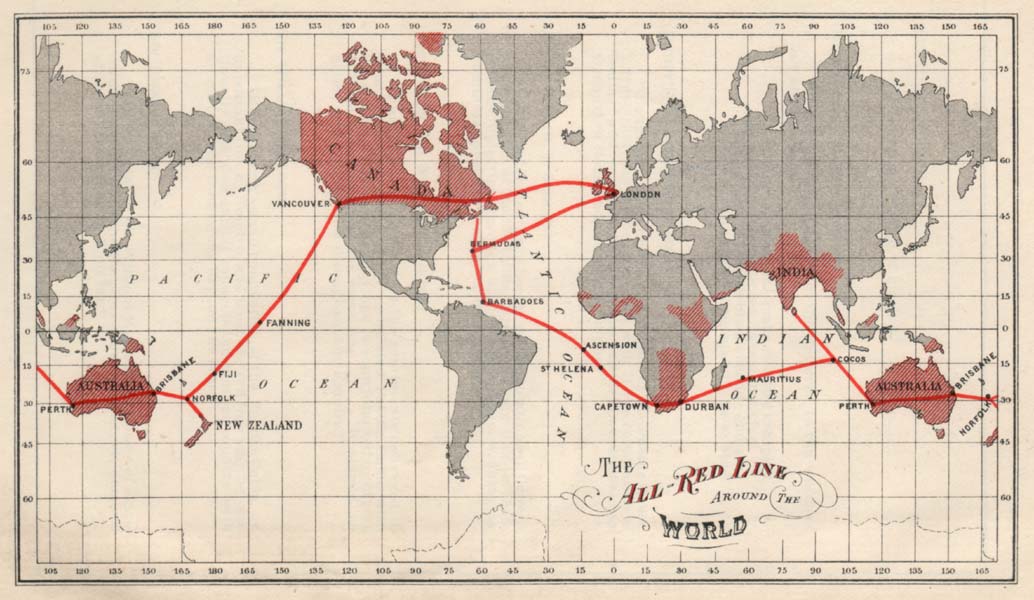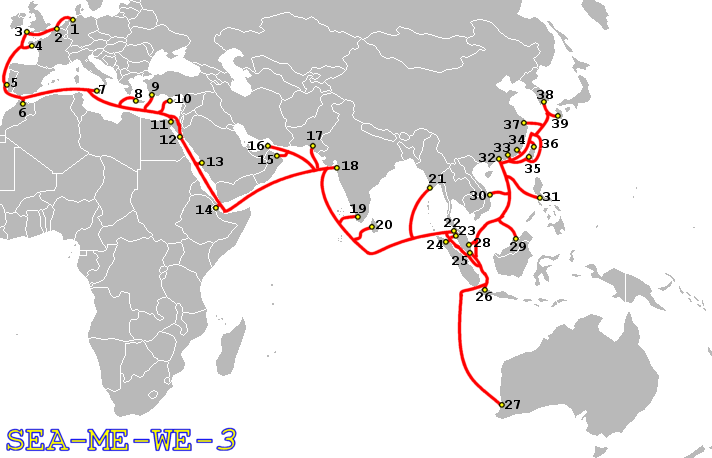
This series surveys the more recent history of submarine cables in the Asia Pacific, looking at key movements in the region over the past year.
For over 150 years, submarine cables have carried our communications across oceans; first telegraph, then voice and data. The first international subsea telegraph cable was laid between Dover and Calais in 1850; an experiment that only worked for one day.
The Asia Pacific region saw its first subsea cables deployed in the 1860s, with British cables extending to India. By the mid 1870s, cables had extended to Singapore, China, Australia and New Zealand.
In 1902-03, the Commercial Pacific Cable crossed the Pacific, connecting the US mainland with Hawaii, Midway, Guam and the Philippines. The British ‘All Red Line’ also extended to connect Canada with Australia, New Zealand and Fiji at around the same time.

Figure 2 — The British ‘All Red Line’ subsea telegraph system.
Source: George Johnson (1836-1911) [Public domain], via Wikimedia Commons.
Since then, cables have continued to be laid, maintained, damaged, repaired, retired, replaced and repurposed. Cable materials and signal transmission techniques have, unsurprisingly, made a quantum leap in this time, with the most recently deployed optical fibre cable systems boasting the ability to carry 10Tbps (100 x 100Gbps wavelengths) on a fibre pair.
In this series, I’ll survey the more recent history of submarine cables, looking at key movements in the Asia Pacific region over the past year, including plans for cables in the imminent future.
Australia to Singapore
Fibre routes between Australia and Asia, despite their proximity, have historically suffered from poor performance, due in part to less-than-direct routes to many Asian economies, those in South Asia in particular. A large amount of Australia-Asia traffic is routed to Guam, either by the Pipe Pacific Cable (PPC-1) or Australia-Japan Cable (AJC), where it can then traverse the Asia-America Gateway (AAG) cable to Hong Kong and Singapore, or continue on to South East Asia (the Philippines, Brunei, Viet Nam, Malaysia and Thailand).
The more direct route to South East Asia is provided by SEA-ME-WE 3 (SMW-3), which was completed in 2000 and spans 39,000 kms, connecting Australia’s west coast through to Indonesia and Singapore, where it comes to something of a fork. Branching off to the north-east, the cable reaches South Korea via the South China Sea, providing access to Brunei, the Philippines, Viet Nam, Macau, Hong Kong, Taiwan and China on the way. The other branch continues west, reaching Sri Lanka, India and Pakistan before continuing on to the Middle East and North Africa, then Western Europe.

Figure 2 – SEA-ME-WE 3 route.
Source: J.P.Lon [CC BY-SA 3.0]
As extensively connected throughout the region as SMW-3 is, it has suffered faults in its Perth-Singapore segment in recent years. Recent faults on SMW-3 have often taken a month or more to be resolved, such is the difficulty involved in repairing subsea network issues.
Given these difficulties in connecting such close neighbours, the opportunity to more directly connect Australia and Asia has been taken by Vocus, with their recently-commissioned Australia-Singapore Cable (ASC), and the INDIGO consortium, whose cable, Indigo West has completed construction and will be ready for service early this year.
Both systems target Singapore as their Asian hub — not an uncommon strategy. As John Hibbard, president of the Pacific Telecommunications Council told Nicole Starosielski in her book The Undersea Network, “Singapore is about the most wired country in the world. The only reason it doesn’t move is because it is tied down by all of these undersea cables”. By improving latency and reliability to the very-connected Singapore, the new cables should provide Australia with improved connectivity to its South and South East Asian neighbours.
Both cables leave the Australian mainland via Perth, reaching Singapore via the very much ‘on the way’ Jakarta. Indigo West will connect with the more populated Australian east coast via the Indigo Central system, a subsea hop from Perth to Sydney, competing with the several existing terrestrial east-west links operated by other carriers.
ASC was deployed by Vocus (a shareholder in SEA-ME-WE 3) in September 2018, slightly ahead of schedule. The cable started carrying customer traffic during its final testing phase in order to support customers affected by an outage on SMW- 3. However, ASC was beset by a fault of its own in mid-December 2018, with the affected branch toward Singapore remaining offline for the remainder of the calendar year.
Fortifying domestic connectivity in the Pacific
In French Polynesia, the Natitua cable, commissioned on 18 December 2018, connects eight atolls in the archipelago of Tuamotu and the two islands of Marquisas. These locations were previously unserved by the existing Honotua cable, which connects the economy’s largest island, Tahiti, to four other islands domestically, and internationally to Hawaii. The Natitua system will reach a further 10 islands via microwave extensions, delivering broadband connectivity to 22,000 French Polynesians.
Over in Tonga, a domestic extension to the Tonga Cable system was completed in January 2018. The Tonga Cable Domestic Extension (TCDE), which initially connected Nuku’alofa, Tonga, to Suva, Fiji, extends fibre optic connectivity to the outer island groups of Vava’u and Ha’apai.
Despite this new connectivity, Tonga suffered from a cut to both their International and domestic submarine cables in January, cutting Internet and international voice communication to the economy while suitable backup satellite capacity could be arranged. At the time of writing, the international cable has been repaired, but the cause of the outage has not been determined.
Contributor: Jonathan Brewer.
Next in this series, we look at new submarine developments in Papua New Guinea.
The views expressed by the authors of this blog are their own and do not necessarily reflect the views of APNIC. Please note a Code of Conduct applies to this blog.
